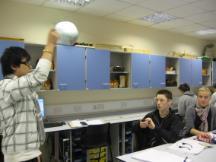Probing the Heart of Matter (PRO)
Cosmology and particle physics are two areas of fundamental research that students often hear of through the media.
Through reading, work on various websites and the use of packages, the students also study the development of the nuclear model, the quark-lepton model to describe the behaviour of matter on a sub-atomic scale, and see how current knowledge supports the Big Bang theory of how the Universe came into being.This chapter gives some insight into these, allowing students to (i) see how particles can be accelerated, (ii) why high energies are needed to break particles into their constitutents and to see fine structure and (iii) see and inquire into the results of collisions and other interactions.

The photo shows students exploring circular motion.
The main physics content areas are:
- Alpha scattering:nuclear model of the atom
- Electrostatic force between point charges
- Collisions: momentum and energy
- Motion in a circle
- Mass-energy interconversion
- Force and potential in a radial electric field
- Charged particles in electric and magnetic fields
- The quark-lepton model
